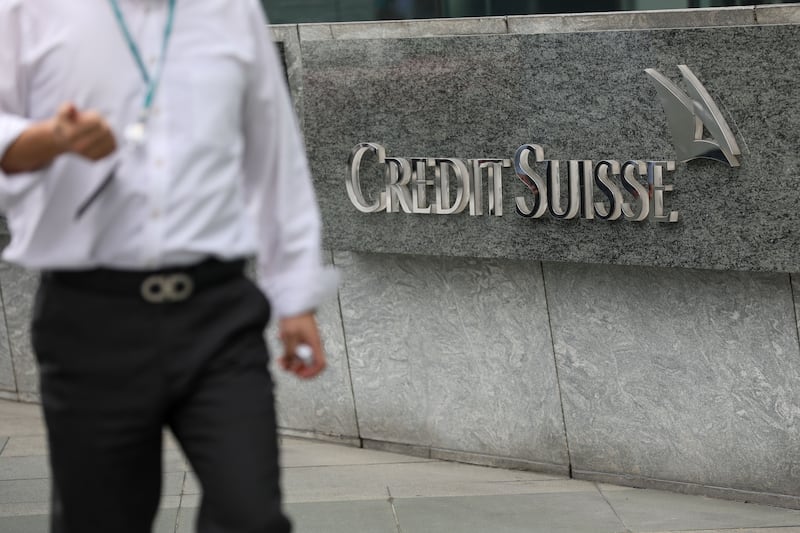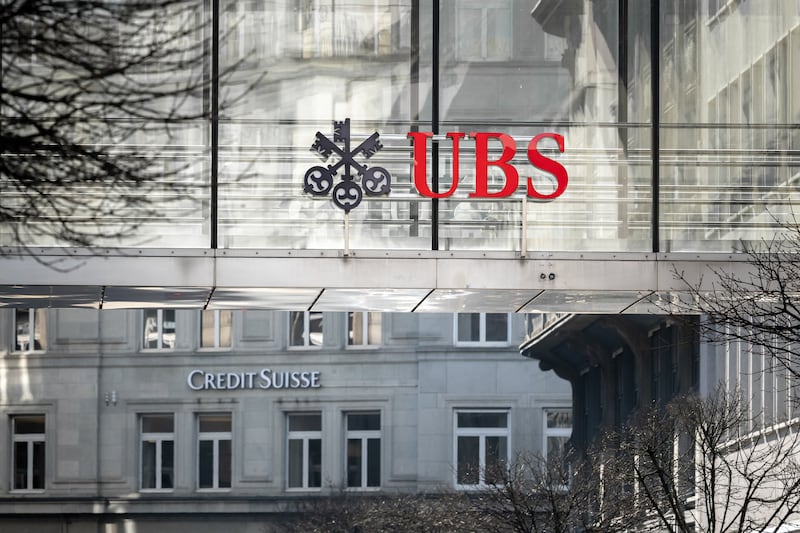Jerome Powell, the world’s most powerful central banker, is said to impress associates with his ability to repeat their sentences backwards to them. But this week, he was forced into reverse on his own words.
The Federal Reserve chairman of five years surprised financial markets on March 7th when he told the US senate banking committee that his organisation would likely need to raise rates more aggressively than previously expected, to control inflation.
But, rattled by the banking crisis that has erupted in the meantime – taking down three mid-sized US banks, led by Silicon Valley Bank (SVB), and resulting in a rescue takeover of Credit Suisse on this side of the Atlantic – the Fed’s monetary policy committee opted on Wednesday for just a quarter of a percentage point rate increase, to 4.75-5 per cent, even as US inflation continues to run at three times its 2 per cent target.
A survey of Fed officials on where they see rates at the end of the year – or what is known as the dot plot – points to them peaking at 5.1 per cent, well below the 5.5-5.75 per cent many economists had been pricing in immediately after Powell addressed lawmakers earlier this month.
READ MORE
The risks of further fallout have left investors nervous and while the Fed is not pricing in any rate cuts this year, markets very much are
Powell signalled that the prospect of banks holding back on doling out loans as they navigate current turmoil would in a way “substitute” for rate hikes. “We see the likelihood of credit tightening,” he said. “We know that that can have an effect on the macro economy.”
“Jerome Powell and his colleagues are clearly concerned about the impact of recent events on credit conditions which may impact lending to households and businesses, slow the economy, and weigh on inflation. While this would do some of its job for it, in bringing inflation back to target, it won’t do so in the way that it will have wanted,” said Craig Erlam, a senior markets analyst with currency broker Oanda.
“What’s more, the risks of further fallout have left investors nervous and while the Fed is not pricing in any rate cuts this year, markets very much are.”
A fresh wobble across global financial markets following the Fed move – with the KBW Bank Index of US banking stocks closing hours later down 4.7 per cent, and European banking shares declining as much as 2.8 per cent on Thursday – suggests that investors are concerned the central bank had not done enough to ease concerns about the banking system.
We see the likelihood of credit tightening. We know that that can have an effect on the macro economy
The fear is that a tightening of credit that the Fed is hoping for might turn into a full-blown credit crunch. Almost a third of fund managers now see a “systemic credit event” as the top risk to the markets, compared to about 25 per cent who highlighted sticky inflation as the biggest threat, Bank of America said this week based off its latest monthly survey of global money managers.
“This is the Fed making the same policy error that it has routinely made in its history,’’ Don Calcagni, chief investment officer for the wealth manager Mercer Advisors, told the New York Times. ‘’I think the Fed is slow to react to significant stress in the banking system.”

Financial markets are now pricing in US rates falling to 4.1 per cent by the end of this year, according to Conall Mac Coille, an analyst with Davy.
US bank shares have fallen in value by 27 per cent over the past month, led by regional lenders, while the Stoxx 600 Europe Banks index has fallen more than 12 per cent.
The Iseq Financial index, dominated by the three remaining Irish banks, is down almost 2 per cent on the month, notwithstanding some volatile share price movements during the period – even as the Government, regulators and analysts insist that domestic lenders remain well cushioned from the crisis.
Banking rules
Events over the past few weeks have also prompted fresh scrutiny of erosion in the US of globally agreed banking rules – hammered out via the Group of 20 (G20) forum of leading economies – aimed at avoiding repeat of great financial crisis, and the taxpayer bailouts that ensued.
The focus has been on the easing, under then US president Donald Trump five years ago, of the Dodd-Frank regulatory reforms enacted in 2009 to prevent a repeat of excess risk-taking that led to the last crisis. The partial rollback saw the assets threshold for a bank to be considered systemically important rise to $250 billion from $50 billion.
This meant that SVB, which had a $209 billion balance sheet at the end of last year, and New York-based Signature Bank, which also imploded almost two weeks ago with more than $110 billion of assets, escaped the regular stress testing and strict capital and liquid assets requirements that apply to larger US banks and all banks in the EU and UK.
An irrevocable commitment of extraordinary support from the public sector would trigger a ‘viability event’, thus allowing the total write-down of AT1s
Capital reserves protect banks in the event of a shock loss, while liquid assets refer to cash on hand or assets that can be easily converted into cash to meet outgoings.
European regulators and politicians have criticised Washington’s handling of the SVB affair, with the snap decision by the US this month to guarantee the deposits of SVB and Signature Bank – even though US officials had insisted during global reform efforts after the last crisis that bailouts must be a thing of the past.

Close to home, the terms of the shotgun takeover of Credit Suisse by arch-rival UBS last weekend, which will see the company’s shareholder receive three billion Swiss francs (€3 billion) as a group of marginally higher-ranked bondholders face wipeout, has upended the normal hierarchy of debt investors over equity holders.
Swiss authorities decided that investors of Credit Suisse’s ChF16 billion of additional tier 1 (AT1) notes – the riskiest form of bank bonds that can be bailed in at a time of financial stress – will receive none of their money back.
[ UBS agrees to buy Credit Suisse in €3bn deal to avert global banking crisisOpens in new window ]
The Swiss decision triggered a quick response from the European Central Bank (ECB), the Single Resolution Board responsible for the winding down of failing euro zone lenders, and European Banking Authority (EBA), which all insisted in a statement that equity holders will always be the first to bear losses in a similar situation in the EU.
Swiss regulators based their decision to take out the AT1 holders on a contractual clause in Credit Suisse bond documents called a “viability event”. “In particular, according to the AT1 prospectus, an irrevocable commitment of extraordinary support from the public sector would trigger this ‘viability event’ thus allowing the total write-down of AT1s,” noted analysts at DBRS Morningstar, the debt ratings agency.
The authorities have interpreted the Swiss government’s agreement to cover a maximum of ChF9 billion of Credit Suisse losses to get the UBS deal over the line as taxpayer support. However, some of the holders of the AT1 notes are currently weighing up legal action.
Irish banks
Minister for Finance Michael McGrath said this week that Irish banks were “well equipped” to deal with turbulence in the international financial system. He added that they were in “a very different place” to the situation that was faced during the global financial crisis, when the State’s banks, then laden with commercial property loans, had to be rescued by taxpayers after a domestic property bubble burst.
“The regulatory environment is a world apart from what it was. The capital position of the banks, the liquidity resources available to them, and indeed the quality of the loans that they are carrying on their books are dramatically better than they would have been in the lead-up to the last crisis,” he said.
Former Central Bank deputy governor Ed Sibley, who moved to EY Ireland last year to become a partner in financial services, agrees.
“While there are clearly still vulnerabilities in the financial system, fundamentally, the work over the last 15 years has resulted in a much stronger banking system globally, but particularly at European and Irish level,” he said. “There are more tools to prevent banks getting into difficulty, but also to mitigate the risks when they do.”
[ Silicon Valley Bank collapse prompts concerns over banking sectorOpens in new window ]
For now, sector observers draw comfort from the fact that the recent bank failures can be attributed to specific cases of bad management.
During the recent era of ultra-low interest rates, SVB and Signature Bank had sought to make profits by investing tens of billions of dollars of customer deposits in higher-yielding long-term bonds, mainly US government debt. The strategy of borrowing at a low rate and investing in assets with a higher return is known in financial markets jargon as a carry trade.
However, as market interest rates – or bond yields – started to rise dramatically last year amid rising central bank rates, the value of the bond investments dropped, triggering paper losses. Bond values move in the opposite direction to bond yields.
Catastrophically, at a time when better-run banks were upping their insurance against rising rates – through so-called financial hedging contracts – SVB allowed virtually all its rate hedges to expire last year. A failed attempt a little over two weeks ago to sell shares to plug a capital hole in its balance sheet prompted a deposits run on the bank, forcing it into the arms of the Federal Deposit Insurance Corporation (FDIC). Signature Bank, facing similar issues, followed not long after.
US banks were sitting on $620 billion of paper losses from securities that had dropped in value by the end of last year, according to the FDIC.
“Nobody can be particularly complacent, but I don’t think the European banking system has a particular exposure to carry-trade risk,” said Sibley. “While some European banks hold more government debt than others, the ECB has been focused on making sure that there is a conservatism to both the exposure levels and to how it’s being treated from an accounting perspective.”
There are more tools to prevent [Irish] banks getting into difficulty, but also to mitigate the risks when they do
Irish banks have stored most of their excess cash with the ECB in recent years. While they did incur losses when negative central bank rates prevailed, the €67 billion of surplus cash that the three surviving Irish lenders had on their balance sheets as of December is now hugely profitable, with the ECB’s deposit rate now set at 3 per cent.
Meanwhile, Credit Suisse has long stood out as the problem child of the EU banking sector, following a series of scandals, losses, management overhauls and restructuring plans. Having weathered a storm early last October, when unsubstantiated rumours swirled on social media that the bank was facing a Lehman Brothers-type moment, it succumbed to fresh stress this month as the markets sought out other weak links in the system after SVB imploded.
Swiss authorities moved last weekend to push the bank into the arms of UBS, after it became clear that market confidence in Credit Suisse’s was evaporating fast – with daily deposit outflows at one stage last week topping ChF10 billion a day.
In raising interest rates again on Wednesday, the Fed chair Powell has made clear that his main concern, for now, is inflation and that the banking crisis can be contained.
However, the pace at which banks can run into trouble has been changed forever with the advent of banking mobile apps. Consumers can now pull money out of banks with a few clicks of a button, Citigroup chief executive Jane Fraser said at an event in Washington this week.
“It’s a complete turning point from what we’ve seen so far,” she said. “There were a few tweets [about SVB], and then this thing went down a lot faster than it historically happened. And honestly, I think the regulators did a good job reacting very quickly, because you usually have longer to react to that.”














